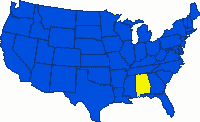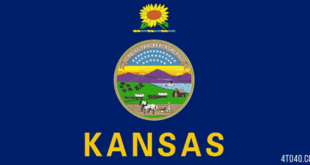 Alabama, one of the southern states of the United States, is largely rectangular in shape and is landlocked except for a short coastline along the Gulf of Mexico. It is bordered by Tennessee on the north, by Georgia on the east, by the Florida panhandle on the south, and by Mississippi on the west. The state was visited by Spaniards in the early 16th century, but the first permanent white settlement (present-day MOBILE) was not established until 1711. Alabama became a state in 1819, and during the Civil War it was a member of the Confederacy. The state was profoundly affected by the civil rights movement of the 1950s and ’60s. Long a primarily agricultural area, Alabama in the late 1980s had a diversified economy, dominated by manufacturing and service industries. The state is named for the Alabama River, whose name was derived from the Alabama Indians, a small Muskogean-speaking group that formerly lived on its banks. The word Alabama probably means “I make a clearing.”
Alabama, one of the southern states of the United States, is largely rectangular in shape and is landlocked except for a short coastline along the Gulf of Mexico. It is bordered by Tennessee on the north, by Georgia on the east, by the Florida panhandle on the south, and by Mississippi on the west. The state was visited by Spaniards in the early 16th century, but the first permanent white settlement (present-day MOBILE) was not established until 1711. Alabama became a state in 1819, and during the Civil War it was a member of the Confederacy. The state was profoundly affected by the civil rights movement of the 1950s and ’60s. Long a primarily agricultural area, Alabama in the late 1980s had a diversified economy, dominated by manufacturing and service industries. The state is named for the Alabama River, whose name was derived from the Alabama Indians, a small Muskogean-speaking group that formerly lived on its banks. The word Alabama probably means “I make a clearing.”
Land & Resources
About two-thirds of Alabama is made up of a low-lying coastal plain, which merges, toward the northeast, into regions of medium-altitude hills and mountains. The highest point in the state is Cheaha Mountain (733 m / 2,405 ft), in the east, and the lowest elevation is sea level, along the Gulf of Mexico.
Physiographic Regions
 Alabama may be divided into four physiographic regions. A vast coastal plain covers the southern half of the state and much of the northwest. The plain includes the famous Black Belt, an area of productive black-clay soils that forms a narrow east-west band across the middle of the state. The southeast also has good farmland, but the soils of the rest of the coastal plain are generally deeply weathered and are of limited agricultural value. A second region, separated from the coastal plain by the FALL LINE, is the PIEDMONT PLATEAU, located in the east central part of the state. It is rolling to hilly, with highly eroded red soils.
Alabama may be divided into four physiographic regions. A vast coastal plain covers the southern half of the state and much of the northwest. The plain includes the famous Black Belt, an area of productive black-clay soils that forms a narrow east-west band across the middle of the state. The southeast also has good farmland, but the soils of the rest of the coastal plain are generally deeply weathered and are of limited agricultural value. A second region, separated from the coastal plain by the FALL LINE, is the PIEDMONT PLATEAU, located in the east central part of the state. It is rolling to hilly, with highly eroded red soils.
The Appalachian Region encompasses much of northeastern Alabama. The eastern portion of this region is an area of sandstone ridges, separated by fertile limestone valleys. The western portion, a continuation of the CUMBERLAND PLATEAU, is a hilly, forested area of poor soils. The fourth region is the Highland Rim, a section of smooth, rolling plains located in the north, astride the TENNESSEE RIVER. Underlaid by limestone, the Highland Rim, as well as the eastern Appalachian Region, has formed sinkholes and caverns as a result of the solution of the limestone in the humid climate.
Rivers and Lakes
Alabama has several major rivers. The main rivers flowing north to south are the Alabama River (507 km / 315 mi long), formed by the confluence, near Montgomery, of the Coosa and Tallapoosa rivers, and the TOMBIGBEE RIVER, which rises in Mississippi. The Alabama and Tombigbee meet in the southwestern part of the state and then form the Mobile and Tensaw rivers, which continue south to Mobile Bay (an arm of the Gulf of Mexico). Other important rivers are the CHATTAHOOCHEE, which forms part of the eastern border of Alabama, and the Tennessee, which flows west across nearly all of the northern part of the state.
Alabama has no large natural lakes. Dams on rivers, however, have created several extensive artificial lakes, the largest being Guntersville Lake (272 sq km / 105 sq mi), on the Tennessee River.
Climate
Alabama has a humid, subtropical climate. Summers are hot (average July temperature, 27 deg C / 80 deg F) and humid, with frequent heavy thunderstorms. Winters are cool (average January temperature, 7 deg C / 45 deg F), with considerable precipitation, including some snow in the north. The amount of annual precipitation generally increases from north to south, ranging from 1,321 mm (52 in) at HUNTSVILLE to 1,600 mm (63 in) at Mobile. Southern Alabama is occasionally affected by hurricanes in the late summer. Tornadoes, which are associated with cold fronts, are most common in the months of March and April.
Vegetation and Animal Life
About two-thirds of Alabama is covered by forests, largely made up of southern yellow pine, red cedar, and other conifers. The most common deciduous trees are hickory, sweet gum, and several species of oak. Alabama has a varied wildlife population with numerous deer, foxes, bobcats, game birds, and other animals. Large numbers of migratory ducks and geese winter in the state.
Mineral Resources
Alabama has significant deposits of several important minerals. Coal, iron ore, and limestone–all used in the production of iron and steel–are found in the north central part of the state, notably around Birmingham. Major crude-petroleum fields are in the southwest, and bauxite deposits are in the southeast.
People
Alabama has a population of 4,040,587 (1990 resident census), giving the state an average population density of 30.7 persons per sq km (79.6 per sq mi). In the decade from 1980 to 1990, Alabama’s rate of growth was 4.3%. In 1990 about 74% of the population were white, 25% were black, and there were small numbers of American Indians, Hispanics, and Asians. After several decades of considerable net out-migration (mainly a result of blacks leaving Alabama for better opportunities elsewhere), the state had a modest net in-migration between 1970 and 1980. After an out-migration in the early 1980s, there was again an in-migration from 1985 to 1988. About two-thirds of the people live in areas defined as urban; the largest cities are BIRMINGHAM, MOBILE, MONTGOMERY, HUNTSVILLE, and TUSCALOOSA. The great majority of all Alabamians were born in the United States of American parents. The majority of the people are Protestants.
Education
Alabama established a statewide public school system in 1854, but schools received inadequate financial support until the 20th century. Almost all black and white children attended separate public schools until the 1960s. By 1980, slightly more than 55% of Alabama’s residents of 25 years of age or more were high-school graduates. Alabama’s more important institutions of higher education include Auburn University (founded 1856), main campus at Auburn University; Jacksonville State University (1883), at Jacksonville; Samford University (1841), at Birmingham; Troy State University (1887), main campus at Troy; Tuskegee University (1881), at Tuskegee University; the University of Alabama (1831), campuses at Tuscaloosa, Birmingham, and Huntsville; the University of North Alabama (1872), at Florence; and the University of South Alabama (1963), at Mobile.
Cultural Institutions
Among the museums of the state are the University of Alabama State Museum of Natural History, at Tuscaloosa; the Alabama Space and Rocket Center, at Huntsville; and the Birmingham Museum of Art. The decommissioned World War II battleship Alabama, now anchored in Mobile Bay, also contains a museum. Large libraries include the University of Alabama Library (1,244,000 volumes), at Tuscaloosa, and the Birmingham Public and Jefferson County Free Library. Huntsville, Montgomery, and Birmingham have symphony orchestras, and Birmingham supports a ballet company.
Historical Sites
Russell Cave National Monument (at Bridgeport) contains archaeological records of human habitation dating from at least 7000 BC. At Mound State Monument (near Moundville) are several large mounds of the Indian MOUND BUILDER culture, and Horseshoe Bend National Military Park (near Dadeville) was the site of a decisive defeat (1814) of the Creek Indian Confederacy by Andrew JACKSON. At Tuskegee Institute National Historic Site (Tuskegee) are early buildings of the noted college founded (1881) for blacks. The first capitol (the present state capitol) and the first White House of the Confederacy are both in Montgomery. Alabama has many historic homes, some built before the Civil War.
Communications
Alabama has plentiful radio stations and a number of commercial and educational television stations. Cable television systems also are available. Among the more influential daily newspapers are the Birmingham News, the Huntsville Times, and the Montgomery Advertiser. The state’s earliest newspaper was the short-lived Mobile Centinel [sic], which is the Mobile Register, founded in 1813.
Tourism
Alabama has a substantial tourist industry. Many vacationers stay at beach resorts along the Gulf of Mexico, notably on Dauphin Island, at the entrance to Mobile Bay. Hunters and anglers are attracted by the state’s ample opportunities for such activity, and many tourists visit Alabama’s historic sites, state parks, and national forests.
History
Excavations of archaic Indian remains indicate that people lived in the region of Alabama at least as early as 7000 BC. During the Mound Builder, or Mississippian, cultural period (AD 700-1700), large temple mounds were built along the major rivers of the state, notably around Moundville. By the early 16th century this remarkable culture was in a state of decline. At that time, the principal Indian groups in the state were the CHICKASAW, in the northwest; the CHEROKEE, in the northeast; the CREEK, in the center and southeast; and the CHOCTAW, in the southwest.
European Exploration and Early Settlement
European contact with the Alabama area began when the Spanish navigator Alonso Alvarez de Pineda explored Mobile Bay in 1519. In 1540 another Spaniard, Hernando DE SOTO, led an army of about 500 men through Alabama; on Oct. 18, 1540, they crushed a large force of Choctaw under Chief Tuscaloosa. The Spanish failed to establish a firm foothold in Alabama, and the French founded (1711) the first permanent white settlement, at present-day Mobile. The French also established large farms, and in 1719 the first black Africans arrived to work as slaves on the farms.
In 1763 France ceded Alabama to Great Britain, and in 1783 most of it became part of the United States. The region around Mobile had been taken by the Spanish during the American Revolution, and it was captured by the United States in 1813, during the War of 1812. Also during that conflict, at the Battle of Horseshoe Bend (Mar. 27, 1814), the power of the Creek Indians was broken by U.S. troops under Andrew Jackson. In the following 25 years nearly all of Alabama’s Indians were removed to the western United States.
Statehood
Alabama was organized as a separate territory in 1817, and on Dec. 14, 1819, it was admitted to the Union as the 22d state. Huntsville was the first capital; the capital was moved to Cahaba in 1820, to Tuscaloosa in 1826, and, finally, to Montgomery in 1847. The state’s population grew from 127,000 in 1820 to 964,000 (435,000 of whom were slaves) in 1860. The economy was dominated by large plantations (mostly in the Black Belt) that produced cotton for export. The rivers were the prime means of transportation, although the state’s first railroad began operations in 1832, and by 1860 about 1,100 km (683 mi) of railroad track had been laid. The state was overwhelmingly rural; Mobile, a growing seaport, was the only sizable city.
The Civil War and Reconstruction
Most white Alabamians viewed slavery as an integral part of their economic and social systems, and they opposed attempts to abolish it. Soon after the election of President Abraham LINCOLN, perceived by Alabamians as a particularly strong opponent of slavery, Alabama seceded (Jan. 11, 1861) from the Union, the fourth state to do so. In February 1861, the Confederate States of America was organized at Montgomery, and Jefferson DAVIS was inaugurated as its president at the Alabama state capitol. Montgomery remained the Confederate capital until May 1861. Alabama contributed about 100,000 troops to the Confederacy, and perhaps 25% of them died during the Civil War. No major land battle was fought in the state, but the Union admiral David G. FARRAGUT won an important naval engagement at Mobile Bay in August 1864. Union armies captured the Tennessee Valley in 1862 and took Montgomery in early 1865.
The Reconstruction period, which followed the Confederate surrender in April 1865, was one of confusion in Alabama. Because it refused to ratify the 14th Amendment to the U.S. Constitution, Alabama was placed under military rule in 1867. After the amendment was ratified, and blacks were assured citizenship, Alabama reentered (June 1868) the Union. During the next few years black and white Republicans exercised considerable power, but by 1874 white Democrats, including numerous former supporters of the Confederacy, had regained control of the state. In the following years racial segregation was written into many state and local laws.
Civil Rights
Race relations were a major issue in Alabama in the 1950s and 1960s, as civil rights advocates worked to end racial segregation in the state. During 1955-56, Martin Luther KING, Jr., organized a black boycott that ended racially separate seating on municipal buses in Montgomery. In 1954 the U.S. Supreme Court had ruled racial segregation in public schools to be unconstitutional, but white officials in Alabama avoided implementing the decision until 1963, when, after tense confrontations between Gov. George C. Wallace and federal officials, integration was begun.
In 1963 four black children were killed when a bomb destroyed part of their Birmingham church. The incident, widely deplored in the nation, helped create the atmosphere for passage of the landmark federal Civil Rights Act of 1964. In 1965 King led a march from SELMA to Montgomery to protest discrimination in voter registration. The U.S. Congress responded with the Voting Rights Act of 1965, which helped add many blacks to the voting rolls in Alabama and thereby encouraged white politicians in the state to moderate their views in order to attract black votes.
By the early 1970s most of Alabama’s schools had been integrated. Progress continued for blacks through the 1970s and into the 1980s, and by 1984 Alabama had 25 black mayors. Governor Wallace, whose tenure had spanned the civil rights movement, retired in 1987 after four (nonconsecutive) terms in office. His successor, Guy Hunt, was the state’s first Republican governor in 112 years; Hunt was removed from office in April 1993, after being convicted of a felony charge of violating an Alabama ethics law. Lt. Gov. Jim Folsom, Jr. took the oath of office as governor on Apr. 22, 1993.
 Kids Portal For Parents India Kids Network
Kids Portal For Parents India Kids Network









